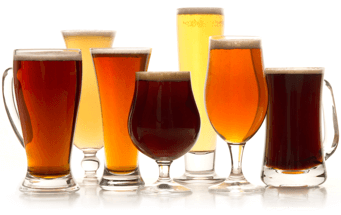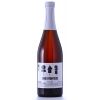To Øl - Sans Frontière
-
ABV:
7.0% -
Serving Temperature:
40-45° F -
Suggested Glassware:
Tulip, Chalice or Oversized Wine Glass
While we generally suggest you enjoy highly hopped beers as soon as possible since the full bouquet of hoppy qualities will fade relatively quickly, this beer has also been bottle-conditioned with Brettanomyces, and that crazy-ass wild bug is going to continue working on the brew for quite some time. As it matures, funky tartness will come up in the mix, while hoppiness declines—all atop a quality Belgian beer base, so it’s quite likely that after a year plus in the bottle, you’ll be drinking a very different beer. But that’s just it—this is beer sans frontière—meaning borderless, or no limits—forget the roadmap, let it ride, and check in on it every 6-9 months or so and enjoy the journey. Ah, how time travel broadens the mind…
We should mention that this beer is brand new to the United States—and we’ve snatched up all but 30 cases that are going to be split by Chicago, California, and New York—so our members will be hoarding the vast majority of the nation’s supply of this very tasty brew. You greedy animals you!
The Gypsies are Coming! The Gypsies are Coming!!
And we should be happy about it. For a long time in the craft beer industry, the concept of “brewery-less” brewers was one that made many uncomfortable. The idea of “contract brewing” is often misunderstood and confused with what has become a new model for producing beer that has resulted in huge strides in the better beer movement. Typically, contract brewing is the term applied to beers that are brewed at a brewery owned by someone other than the “brewer” cited on the label—so, you give someone else your recipes, and they make the beer for you. This happened a lot in the 1990s, in many cases when beer marketing companies decided to ride the wave of the craft beer boom at that time, concocting a less than stellar product, outsourcing it, and shoving it to market as quickly as possible. All too often, those beers were not great—be it formulation or simply a remote-based disconnectedness from quality control. But there are other cases of contract brewing that serve as wonderful arrangements—such as when a brewery cannot keep up with demand and decides to have some of their beer brewed at an already established location to supplement their own production. The Boston Beer Company (makers of Samuel Adams) has relied on this approach for many years with phenomenal success, and we don’t think of them as sell-outs or somehow “half-assing” it…
So there seems to be less resistance to the idea if you at least have your own brewery where you are making some of your beers. But starting a brewery is a massive capital investment, and some entrepreneurs (usually homebrewers making beer in their kitchens) are looking to get their creativity into the game without all the crushing debt that stainless steel carries. So a number of brewers do not have their own breweries these days—and they’ve done great things for beer. Some have lovingly taken on the title of “gypsy brewers”, as they hop from place to place when making their brews. Is this the coming of the “gypsy apocalypse?” If it is, bring it on, because the beers coming out of this model have been some of the most important beers to hit the scene in the past 5-6 years.
Widely regarded as the grandfather of gypsy brewing (though he’s still a pretty young guy), Danish brewer Mikkel Bjergsø of Mikkeller fame has made a name for himself and better beer around the world—all without a brewery to call his own since going pro in 2006. Just a year earlier, Mikkel was teaching at a college in Denmark. Two of his students, Tobias Emil Jensen and Tore Gynther were chatting him up about the fact that most Danish breweries were producing lackluster beers, focusing almost exclusively on a century of tradition rather than newfound creativity and expression. The three of them agreed that the only way to get beer of the quality and caliber they sought would be to brew it themselves—basically the identical conversation had by so many brewers, be they from the 1970s, 80s, 90s, or these days, in markets where good beer is scarce. And rather than just talk about it, they hatched a plan. Soon they were allowed to borrow the school’s kitchen during the off hours, where they began to brew. This meant that most of the brews were made between the hours of 10 pm and 6 am on weekdays, which resulted in some hard school days for the two pupils as well as their teacher, but the hunt for quality and potent beers had begun, and a concept of never compromises that quality was founded.
The experiment had important results. The following year, Mikkel started Mikkeller, which has garnered worldwide global acclaim, while Tobias and Tore continued to craft brew privately for the next four years. In 2010, they believed that they, and their recipes, were ready, and founded To Øl (Danish for “Two Beers”). Word spread fast and as Mikkel heard his old students’ plans, he insisted on making a collaborative brew between Mikkeller and To Øl, which became the first beer released by To Øl – Overall IIPA. Ever since then To Øl has continued to brew beers that push the boundaries of beers. To quote Hannibal from the A-Team, we love it when a plan comes together…
Their approach remains to always use the best raw materials, never make compromises with taste, and not to follow fashion or certain styles. Basically, to always have an open mind. And part of that open mind could be applied to understanding that they do not have their own brewery. In fact, they do much of their brewing at Belgium’s De Proef Brouwerij (where Mikkeller brews a number of their beers, in fact). It’s enabled them to focus just on the beer, and remain nimble and agile. In just about two years of operation, they’ve gained critical acclaim within the craft beer scene, and have put out an impressive number of beers—one of which, called Sans Frontière (meaning without borders or roughly, “no limits”)—we’re featuring for our members this month. Quite a fitting title for Danish brewers producing beers at a Belgian brewery. Enjoy!

Unmatched Variety by style, brewery & country
Choose from Five different Beer Clubs offering unmatched variety by brewery,
country of origin, and beer style to suit your specific tastes.


